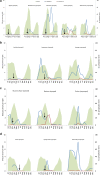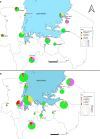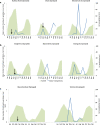Malaria vector species composition and entomological indices following indoor residual spraying in regions bordering Lake Victoria, Tanzania
- PMID: 33115495
- PMCID: PMC7594290
- DOI: 10.1186/s12936-020-03452-w
Malaria vector species composition and entomological indices following indoor residual spraying in regions bordering Lake Victoria, Tanzania
Abstract
Background: Vector control through long-lasting insecticidal nets (LLINs) and focal indoor residual spraying (IRS) is a major component of the Tanzania national malaria control strategy. In mainland Tanzania, IRS has been conducted annually around Lake Victoria basin since 2007. Due to pyrethroid resistance in malaria vectors, use of pyrethroids for IRS was phased out and from 2014 to 2017 pirimiphos-methyl (Actellic® 300CS) was sprayed in regions of Kagera, Geita, Mwanza, and Mara. Entomological surveillance was conducted in 10 sprayed and 4 unsprayed sites to determine the impact of IRS on entomological indices related to malaria transmission risk.
Methods: WHO cone bioassays were conducted monthly on interior house walls to determine residual efficacy of pirimiphos-methyl CS. Indoor CDC light traps with or without bottle rotator were hung next to protected sleepers indoors and also set outdoors (unbaited) as a proxy measure for indoor and outdoor biting rate and time of biting. Prokopack aspirators were used indoors to capture resting malaria vectors. A sub-sample of Anopheles was tested by PCR to determine species identity and ELISA for sporozoite rate.
Results: Annual IRS with Actellic® 300CS from 2015 to 2017 was effective on sprayed walls for a mean of 7 months in cone bioassay. PCR of 2016 and 2017 samples showed vector populations were predominantly Anopheles arabiensis (58.1%, n = 4,403 IRS sites, 58%, n = 2,441 unsprayed sites). There was a greater proportion of Anopheles funestus sensu stricto in unsprayed sites (20.4%, n = 858) than in sprayed sites (7.9%, n = 595) and fewer Anopheles parensis (2%, n = 85 unsprayed, 7.8%, n = 591 sprayed). Biting peaks of Anopheles gambiae sensu lato (s.l.) followed periods of rainfall occurring between October and April, but were generally lower in sprayed sites than unsprayed. In most sprayed sites, An. gambiae s.l. indoor densities increased between January and February, i.e., 10-12 months after IRS. The predominant species An. arabiensis had a sporozoite rate in 2017 of 2.0% (95% CI 1.4-2.9) in unsprayed sites compared to 0.8% (95% CI 0.5-1.3) in sprayed sites (p = 0.003). Sporozoite rates were also lower for An. funestus collected in sprayed sites.
Conclusion: This study contributes to the understanding of malaria vector species composition, behaviour and transmission risk following IRS around Lake Victoria and can be used to guide malaria vector control strategies in Tanzania.
Keywords: Anopheles arabiensis; Anopheles funestus; Anopheles gambiae; Indoor residual spraying; Malaria vectors; Pirimiphos-methyl; Seasonality; Species composition; Tanzania.
Conflict of interest statement
The authors declare that they have no competing interests.
Figures






Similar articles
-
Indoor residual spraying with micro-encapsulated pirimiphos-methyl (Actellic® 300CS) against malaria vectors in the Lake Victoria basin, Tanzania.PLoS One. 2017 May 10;12(5):e0176982. doi: 10.1371/journal.pone.0176982. eCollection 2017. PLoS One. 2017. PMID: 28489935 Free PMC article.
-
Impact of indoor residual spraying with pirimiphos-methyl (Actellic 300CS) on entomological indicators of transmission and malaria case burden in Migori County, western Kenya.Sci Rep. 2020 Mar 11;10(1):4518. doi: 10.1038/s41598-020-61350-2. Sci Rep. 2020. PMID: 32161302 Free PMC article.
-
Reduced exposure to malaria vectors following indoor residual spraying of pirimiphos-methyl in a high-burden district of rural Mozambique with high ownership of long-lasting insecticidal nets: entomological surveillance results from a cluster-randomized trial.Malar J. 2021 Jan 21;20(1):54. doi: 10.1186/s12936-021-03583-8. Malar J. 2021. PMID: 33478533 Free PMC article. Clinical Trial.
-
Indoor residual spraying for preventing malaria in communities using insecticide-treated nets.Cochrane Database Syst Rev. 2019 May 23;5(5):CD012688. doi: 10.1002/14651858.CD012688.pub2. Cochrane Database Syst Rev. 2019. Update in: Cochrane Database Syst Rev. 2022 Jan 17;1:CD012688. doi: 10.1002/14651858.CD012688.pub3. PMID: 31120132 Free PMC article. Updated.
-
Entomological monitoring data driving decision-making for appropriate and sustainable malaria vector control in Côte d'Ivoire.Malar J. 2023 Jan 12;22(1):14. doi: 10.1186/s12936-023-04439-z. Malar J. 2023. PMID: 36635720 Free PMC article. Review.
Cited by
-
Impact of different mosquito collection methods on indicators of Anopheles malaria vectors in Uganda.Malar J. 2022 Dec 19;21(1):388. doi: 10.1186/s12936-022-04413-1. Malar J. 2022. PMID: 36536428 Free PMC article.
-
Species Composition, Seasonal Abundance, and Biting Behavior of Malaria Vectors in Rural Conhane Village, Southern Mozambique.Int J Environ Res Public Health. 2023 Feb 17;20(4):3597. doi: 10.3390/ijerph20043597. Int J Environ Res Public Health. 2023. PMID: 36834293 Free PMC article.
-
The Comparative Performance of Klypson 500WG and 2GARD-WP Sprayed on Different Wall Surfaces Against Anopheles gambiae s.l. in Lower Moshi, Northern Tanzania.Trop Med Infect Dis. 2025 Feb 27;10(3):63. doi: 10.3390/tropicalmed10030063. Trop Med Infect Dis. 2025. PMID: 40137817 Free PMC article.
-
Empowering rural communities for effective larval source management: A small-scale field evaluation of a community-led larviciding approach to control malaria in south-eastern Tanzania.Parasite Epidemiol Control. 2024 Oct 4;27:e00382. doi: 10.1016/j.parepi.2024.e00382. eCollection 2024 Nov. Parasite Epidemiol Control. 2024. PMID: 39434900 Free PMC article.
-
Insights into the biology and insecticide susceptibility of the secondary malaria vector Anopheles parensis in an area with long-term use of insecticide-treated nets in northwestern Tanzania.Parasit Vectors. 2024 Dec 30;17(1):549. doi: 10.1186/s13071-024-06634-6. Parasit Vectors. 2024. PMID: 39736795 Free PMC article.
References
-
- Gimnig JE, Otieno P, Were V, Marwanga D, Abong’o D, Wiegand R, et al. The effect of indoor residual spraying on the prevalence of malaria parasite infection, clinical malaria and anemia in an area of perennial transmission and moderate coverage of insecticide treated nets in western Kenya. PLoS ONE. 2016;11:e0145282. doi: 10.1371/journal.pone.0145282. - DOI - PMC - PubMed
-
- Kanyangarara M, Mamini E, Mharakurwa S, Munyati S, Gwanzura L, Kobayashi T, et al. Reduction in malaria incidence following indoor residual spraying with actellic 300 CS in a setting with pyrethroid resistance: Mutasa District Zimbabwe. PLoS ONE. 2016;11:e0151971. doi: 10.1371/journal.pone.0151971. - DOI - PMC - PubMed
-
- Mashauri FM, Kinung’Hi SM, Kaatano GM, Magesa SM, Kishamawe C, Mwanga JR, et al. Impact of indoor residual spraying of lambda-cyhalothrin on malaria prevalence and anemia in an epidemic-prone District of Muleba, North-western Tanzania. Am J Trop Med Hyg. 2013;88:841–849. doi: 10.4269/ajtmh.12-0412. - DOI - PMC - PubMed
MeSH terms
Substances
LinkOut - more resources
Full Text Sources
Miscellaneous

